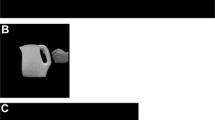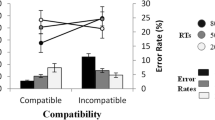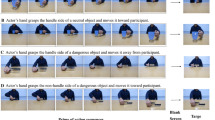Abstract
Perception is linked to action via two routes: a direct route based on affordance information in the environment and an indirect route based on semantic knowledge about objects. The present study explored the factors modulating the recruitment of the two routes, in particular which factors affecting the selection of paired objects. In Experiment 1, we presented real objects among semantically related or unrelated distracters. Participants had to select two objects that can interact. The presence of distracters affected selection times, but not the semantic relations of the objects with the distracters. Furthermore, participants first selected the active object (e.g. teaspoon) with their right hand, followed by the passive object (e.g. mug), often with their left hand. In Experiment 2, we presented pictures of the same objects with no hand grip, congruent or incongruent hand grip. Participants had to decide whether the two objects can interact. Action decisions were faster when the presentation of the active object preceded the presentation of the passive object, and when the grip was congruent. Interestingly, participants were slower when the objects were semantically but not functionally related; this effect increased with congruently gripped objects. Our data showed that action decisions in the presence of strong affordance cues (real objects, pictures of congruently gripped objects) relied on sensory-motor representation, supporting the direct route from perception-to-action that bypasses semantic knowledge. However, in the case of weak affordance cues (pictures), semantic information interfered with action decisions, indicating that semantic knowledge impacts action decisions. The data support the dual-route account from perception-to-action.




Similar content being viewed by others
References
(2010) The university student as a model organism. Nat Neurosci 13(5):521 [Editorial]
Beauchamp MS, Martin A (2007) Grounding object concepts in perception and action: evidence from fMRI studies of tools. Cortex 43:461–468
Borghi AM, Flumini A, Natraj N, Wheaton LA (2012) One hand, two objects: emergence of affordance in contexts. Brain Cogn 80:64–73
Bozeat S, Ralph MAL, Patterson K, Hodges JR (2002) The influence of personal familiarity and context on object use in semantic dementia. Neurocase 8:127–134
Chainay H, Humphreys GW (2002) Privileged access to action for objects relative to words. Psychon Bull Rev 9:348–355
Frey SH (2007) What puts the how in where? Tool use and the divided visual streams hypothesis. Cortex 43:368–375
Gibson JJ (1979) The ecological approach to visual perception. Houghton Mifflin, Boston
Glisky EL (2007) Brain aging: models, methods, mechanisms. CRC Press, Boca Raton
Green C, Hummel JE (2006) Familiar interacting object pairs are perceptually grouped. J Exp Psychol Hum Percept Perform 32:1107–1119
Henrich J, Heine SJ, Norenzayan A (2010) The weirdest people in the world? Behav Brain Sci 33(2–3):61–83
Hodges JR, Spatt J, Patterson K (1999) “What” and “how”: evidence for the dissociation of object knowledge and mechanical problem-solving skills in the human brain. Proc Natl Acad Sci USA 96:9444–9448
Hodges JR, Bozeat S, Lambon Ralph MA, Patterson K, Spatt J (2000) The role of conceptual knowledge in object use evidence from semantic dementia. Brain 123(Pt 9):1913–1925
Humphreys GW, Wulff M, Yoon EY, Riddoch M (2010) Neuropsychological evidence for visual- and motor-based affordance: effects of reference frame and object-hand congruence. J Exp Psychol Learn Mem Cogn 36:659–670
Iacoboni M, Molnar-Szakacs I, Gallese V, Buccino G, Mazzoitta JC, Rizzolatti G (2005) Grasping the intentions of others with one’s own mirror neuron system. PLoS Biol 3:529–535
Kan IP, Thompson-Schill SL (2004) Effect of name agreement on prefrontal activity during overt and covert picture naming. Cogn Affect Behav Neurosci 4:43–57
Kritikos A, Dunai J, Castiello U (2001) Modulation of reach-to-grasp parameters: semantic category, volumetric properties and distractor interference? Exp Brain Res 138:54–61
Kumar S, Yoon EY, Humphreys GW (2012) Perceptual and motor-based responses to hand actions on objects: evidence from ERPs. Exp Brain Res 220:153–164
Kumar S, Riddoch MJ, Humphreys G (2013) Mu rhythm desynchronization reveals motoric influences of hand action on object recognition. Front Hum Neurosci 7:66
Moores E, Laiti L, Chelazzi L (2003) Associative knowledge controls deployment of visual selective attention. Nat Neurosci 6:182–189
Natraj N, Poole V, Mizelle JC, Flumini A, Borghi A, Wheaton LA (2013) Context and hand posture modulate the neural dynamics of tool-object perception. Neuropsychologia 51:506–519
Ochipa C, Rothi LJ, Heilman KM (1992) Conceptual apraxia in Alzheimer’s disease. Brain 115:1061–1071
Pavese A, Buxbaum LJ (2002) Action matters: the role of action plans and object affordances in selection for action. Vis Cognit 9:559–590
Riddoch MJ, Humphreys GW, Price CJ (1989) Routes to action—evidence from apraxia. Cogn Neuropsychol 6:437–454
Riddoch MJ, Humphreys GW, Edwards S, Baker T, Willson K (2003) Seeing the action: neuropsychological evidence for action-based effects on object selection. Nat Neurosci 6:82–89. doi:10.1038/nn984
Riddoch MJ, Humphreys GW, Hickman M, Clift J, Daly A, Colin J (2006) I can see what you are doing: action familiarity and affordance promote recovery from extinction. Cogn Neuropsychol 23:583–605
Roberts KL, Humphreys GW (2010) The one that does, leads: action relations influence the perceived temporal order of graspable objects. J Exp Psychol Hum Percept Perform 36:776–780
Roberts KL, Humphreys GW (2011) Action relations facilitate the identification of briefly-presented objects. Atten Percept Psychophys 73:597–612
Silveri MC, Ciccarelli N (2009) Semantic memory in object use. Neuropsychologia 47:2634–2641
Snow JC, Skiba RM, Coleman TC, Berryhill ME (2014) Real-world objects are more memorable than photographs of objects. Front Hum Neurosci. doi:10.3389/fnhum.2014.00837
Telling AL, Meyer AS, Humphreys GW (2010) Distracted by relatives: effects of frontal lobe damage on semantic distraction. Brain Cogn 73:203–214
Tipper SP, Paul MA, Hayes AE (2006) Vision-for-action: the effects of object property discrimination and action state on affordance compatibility effects. Psychon Bull Rev 13:493–498
Vainio L, Mustonen T (2011) Mapping the identity of a viewed hand in the motor system: evidence from stimulus-response compatibility. J Exp Psychol Hum Percept Perform 37:207–221
Wulff M, Humphreys GW (2013) Visual responses to action between unfamiliar object pairs modulate extinction. Neuropsychologia 51:622–632. doi:10.1016/j.neuropsychologia.2013.01.004
Yoon EY, Humphreys GW (2005) Direct and indirect effects of action on object classification. Mem Cognit 33:1131–1146
Yoon EY, Humphreys GW, Riddoch M (2010) The paired-object affordance effect. J Exp Psychol Hum Percept Perform 36:812–824
Acknowledgments
We thank all the participants for their participation. This research was supported by a Grant from the European Union FP 7 CogWatch Project (FP7-ICT-288912).
Author information
Authors and Affiliations
Corresponding author
Rights and permissions
About this article
Cite this article
Laverick, R., Wulff, M., Honisch, J.J. et al. Selecting object pairs for action: Is the active object always first?. Exp Brain Res 233, 2269–2281 (2015). https://doi.org/10.1007/s00221-015-4296-7
Received:
Accepted:
Published:
Issue Date:
DOI: https://doi.org/10.1007/s00221-015-4296-7




